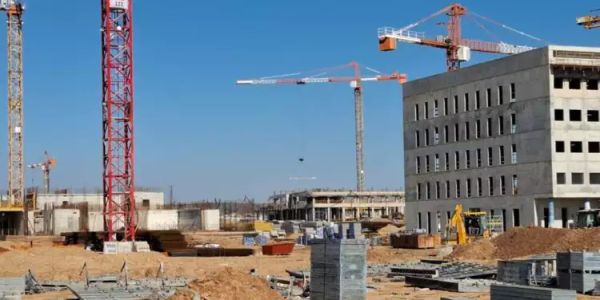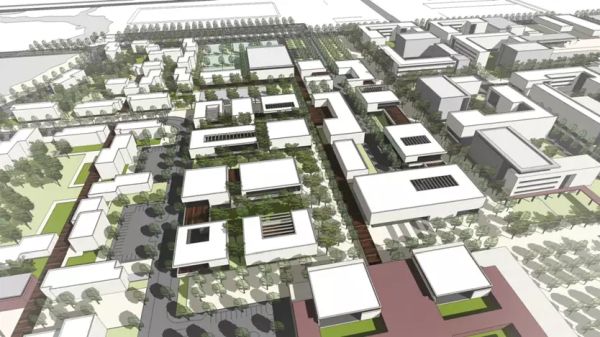by Elyashiv Raichner
January 13, 2025
Original Hebrew posting on Makor Rishon
Translation by me (Jacob) with assistance of Google translate.
The new Kiryat Hamodiin will look more like a high-tech park than a military base.
22 years after the decision to move the IDF to the south, and after a series of delays, struggles and doubts, one can see with one's eyes the new Kiryat Hamodi'in being built with concrete and cement.

Photo of construction of New Intelligence Center at Laikit site
Photo credit: Elyashiv Reichner
It was cool up there, at the top of the scaffolding erected in the heart of the Kiryat Hamodiin construction site. We went up there in a makeshift elevator, wearing helmets and bright vests to look down on the cranes and the skeletons of the new buildings, the perimeter wall and the new roads. Only up there could I believe that this was really happening. 22 years after the decision to move the IDF south, and after years of delays, struggles and doubts regarding the transfer of the Intelligence Corps, you can see with your own eyes the new Kiryat Hamodiin building concrete and mortar.
More than 14,000 soldiers are about to serve in the new Kirya at the Laikit site, between Omer and the Shokat interchange, and between the Bedouin settlements of Lakiya, Umm Batin and Hora. Our host Avi Harel, the CEO of the operation of the Kriya, which is being built by the Shikun and Binui company, provided us with numbers so that we could understand a little the size of the event. The new Kriya is actually a small city that covers about 3,000 dunams, with more than a hundred buildings with a cumulative volume of half a million square meters. It will have 14 dining rooms, a conference center, two banquet halls, a swimming pool, sports fields, and residential buildings that will accommodate 8,100 beds.
The camp, estimated to cost ten billion shekels to build, is set to be innovative and technologically advanced. It will look more like a high-tech park than a military base. Robots will clean the corridors, logistical needs will be provided by a computerized system, and all garbage will be pumped out of the camp walls via underground shafts. Everything will be done according to meticulous planning, down to the diameter of the trunks of the ten thousand mature trees that will be planted here in about three years.

Simulation photo of the New Intelligence Center in the Negev
Simulation photo credit: Ministry of Defense
And there are also schedules. The Kriya headquarters, known as the "core", is supposed to be inhabited for the first time in about a year, in a building whose skeleton has already been completed. Half a year later, BHD 15, the intelligence school where about two thousand soldiers are serving at any given time, is to enter the Kriya. After that, every six months, additional branches of the intelligence will join the Kriya one after the other, until the population is completed in January 2028. This will happen with a delay of six Years from the original date set for the intelligence transition, but eventually it will happen.
Kiryat Modi'in could be a huge boost for the entire Negev. It starts with employment: about a thousand workers will be directly employed in operating the city, and the entire project is expected to create around 30,000 jobs in a wide range of sectors. Since Kiryat Modi'in is a city where workers will be required to have a high security clearance, its food factory, which is expected to produce 30,000 meals daily, will be located outside its walls so that workers without security clearance, including those from nearby Bedouin communities, can work there.
In addition to employment, the move of the Intelligence Corps south is a potential for demographic growth in Beersheba and its surroundings. The Negev is expected to absorb hundreds of families of permanent personnel who will serve in the training center. Ir HaBahadim, the training center established at the Negev Junction, has contributed almost no population to the Negev, because 8,000 of the ten thousand soldiers serving there are regular soldiers who come there for a course of only a few months. In contrast, Kiryat Hamodiain is a completely different story. A large percentage of intelligence personnel serve for many years at the same base. A soldier who will be accepted into the new Kiryat Hamodiain will be able to serve there for up to 25 years, up to the rank of brigadier general. About half of those serving in Kiryat Hamodiain will be permanent personnel, and real estate offers are already being prepared for them in nearby communities.
Another hope is that moving the Intelligence Corps south will increase the percentage of southern residents serving in the prestigious army. Currently, southern residents make up less than two percent of the Intelligence Corps; moving the Military Intelligence Corps south is an opportunity to increase their share. Increasing the percentage of southerners in Military Intelligence will also pay off for the Intelligence Corps in its new location, and certainly for the Negev. In order to promote the integration of young people from the Negev into the Intelligence Corps, a school for intelligence professions was inaugurated about two years ago in the Ramot neighborhood of Be'er Sheva, where pre-military training is held for those scheduled for conscription.
Waiting for the Train
The initiator of the tour of Kiryat Hamodiin is Dr. Esther Luzzatto, a member of the Omer Council, a businesswoman and social activist. About five years ago, she founded the "Israel for the Negev" association, with a clear goal: to ensure that the move to transfer the intelligence bases to the Negev is not torpedoed, and that the Negev maximizes its potential for benefit. About four years ago, after the IDF dragged its feet in promoting the move south, Luzzatto's association filed a petition with the High Court of Justice demanding that the government explain what is holding up the move. In November 2021, the cart was pulled out of the mud; the concession agreement with "Housing and Construction" for the construction of the Kiryat was signed, and the bulldozers began their work.
But even now, when the intelligence transition south has reached the point of no return, Luzzatto mentions that there are at least two more things related to the move that need to be fought for. The first is the transportation story. One of the main demands of the Military Intelligence Service as a condition for moving south was the creation of a fast and efficient transportation solution that would allow their men from the center of the country to reach the new city. The army requested that the railway from Tel Aviv reach directly to Kiryat Hamodiin, so that the soldiers would not have to pass through Beersheba at all. In Beersheba, they were outraged and claimed that the railway line from the center of the country to the south was supposed to be a fast line to the capital of the Negev, without a detour and delay in Kiryat Hamodiin. The proposal of the people of the Negev was that the intelligence officers would arrive by fast train to Beersheba, and from there they would continue by light rail to Kiryat Hamodiin. In August 2020, Minister of Transportation Miri Regev adopted the combined outline of a heavy rail and light rail. The light rail route has already been planned, but a budget for its implementation has not yet been approved, and in a year, as mentioned, soldiers will already be waiting at the station.
The second struggle is in the academic field. In 2018, Ben-Gurion University of the Negev was selected by the Military Academy, the Ministry of Defense, and the Ministry of Finance as the most suitable university to award academic degrees to soldiers and officers who will serve in units expected to move to the Negev. The university has invested many resources to adapt itself to the needs of the army, and the government has also invested in the university so that it is prepared to absorb the soldiers. About two years ago, people in the Negev were surprised to discover that the Ministry of Defense decided to open the academization of the 8200 cyber units to a public tender for all universities. Prof. Daniel Haimovitz, president of Ben-Gurion University, rightly rebelled against the possibility that soldiers from Kiryat Hamodiin would acquire their academic education in the center of the country. Such a possibility, he claimed, would be an insult to David Ben-Gurion's vision and the honor of the university that perpetuates his name. The Negev is still waiting for an announcement that the intelligence officers will acquire their education there.





 Life in Israel Articles
Life in Israel Articles